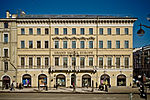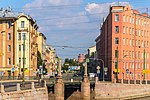Church of St. Catherine (Saint Petersburg)
18th-century Roman Catholic church buildings in Russia18th-century churches in RussiaChurch buildings with domesDomenico Trezzini buildings and structuresDominican churches ... and 4 more
Nevsky ProspektRoman Catholic churches completed in 1783Roman Catholic churches in RussiaRoman Catholic churches in Saint Petersburg

The Catholic Church of St Catherine (Russian: Католическая церковь Святой Екатерины) in St. Petersburg is the oldest Catholic church in the Russian Federation, and the only church with the title of basilica (status granted on 23 July 2013). It is located on the Nevsky Prospekt and is a part of the Archdiocese of Moscow headed by Msgr. Paolo Pezzi.
Excerpt from the Wikipedia article Church of St. Catherine (Saint Petersburg) (License: CC BY-SA 3.0, Authors, Images).Church of St. Catherine (Saint Petersburg)
Nevsky prospect, Saint Petersburg
Geographical coordinates (GPS) Address External links Nearby Places Show on map
Geographical coordinates (GPS)
| Latitude | Longitude |
|---|---|
| N 59.9357 ° | E 30.329 ° |
Address
Храм Святой Екатерины Александрийской
Nevsky prospect
191023 Saint Petersburg (Palace District)
Saint Petersburg, Russia
Open on Google Maps











